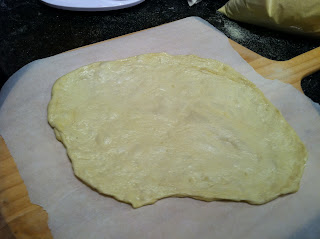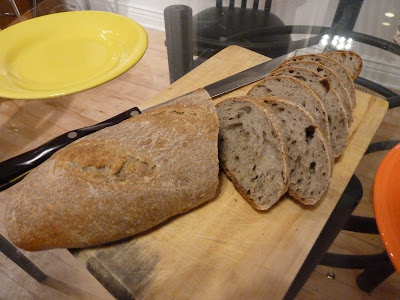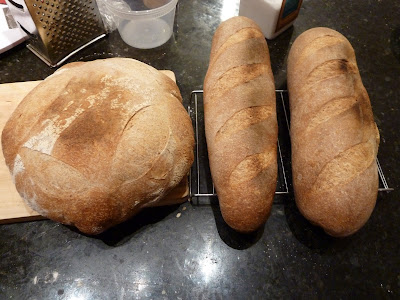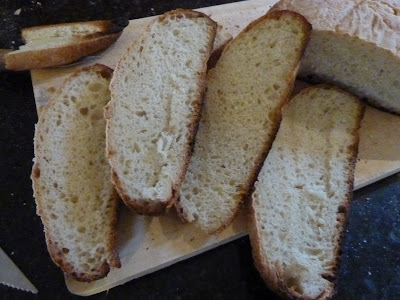Wednesday, February 23, 2011
Sweet Rustic Bread, "Flute Ganachaud" and etc
Here's that sweet rustic bread from pizza night. It's one of my favorites so far. Moist, flavorful crumb with a pretty tender crust. It's made with a poolish starter (from the same batch as the pizza). In fact, Reinhart's recipe makes so much poolish that I did another round of rustic bread this week with extra that I had frozen last week. Even after that I still had enough for the Ganachaud-style baguettes from Leader's book, which I think is the only recipe he gives that uses a poolish pre-ferment.
In addition to being delicious, the rustic bread requires essentially no kneading, which is awesome when you don't have a mixer. The recipe calls for a couple tablespoons of olive oil and five tablespoons of sugar. It's enough fat and sweet to make it a rich bread, but it is still very much bread and not pastry despite the fact that Reinhart pitches it as an alternative to croissants and calls for a powdered sugar topping. It's great for jam, but really it would work for a lot of things.
After mixing the 2 cups of poolish (16 oz) with 4.5 cups of bread flour (20.25 oz), 2 tbsp olive oil, 2 tsp salt, 5 tbsp sugar, 1 cup water and 1/2 tsp instant yeast (or 3/4 tsp dry yeast), the dough rises for about 3 hours. At this point it is kneaded with some flour for a few seconds before another rise of about an hour. After the second rise, Reinhart has you pat the dough into a 6-inch diameter disk and cut 6-8 wedges. The wedges then proof for a couple hours before going into the fridge for the night.
I took a lot of liberties with the recipe, adding a bit of water to make mixing easier and leaving the whole mixture together as a giant loaf rather than doing disks. The timing was also a bit improvised and the final proof lasted a long time while focus was on the pizza. The dough turned out great though. Very bubbly.
So bubbly in fact that it ballooned in the oven. Here it is doing double time with some pizza.
While the overall spring was really good, that extra puff was actually a giant air pocket that covered the entire top of the loaf. I think that contributed to the beautiful color on this loaf.
Yum. The crust is actually tender once it cools, so it wasn't like having a cracker on top of the loaf.
In addition to the pizza and the rustic loaf, I also made a big batch of sour dough and french baguettes using the same pate fermente technique.
Here's a sourdough boule ready to score and pop in the oven.
Group shot. The rolls are evenly split between sourdough and french.
Now, with the extra poolish I had sitting in the freezer from the pizza, I made another batch of the sweet rustic bread and tried a new bread, which is Leader's interpretation of the signature baguette of a famous French baker named Bernard Ganachaud: la flute gana.
The baker's percentage is 9% corn flour, which I subbed with some really finely ground non-instant polenta I had. I imagine it's the same thing more or less. The baguettes turned out well, but I went out for drinks and overproofed them by probably 2 hours. By the time I got back they were a bit saggy. I also need to learn how to use my couche (linen cloth to hold dough) which I used to proof them. I didn't even attempt the signature score which is a long slash that goes the length of the baguette. All things considered they still came out pretty well if misshapen. I'll have to try again.
As I mentioned, I also made a second batch of the rustic bread, which turned out quite well. I did one smaller loaf and 4 disk-like rolls or what have you.
Tuesday, February 15, 2011
Valentine's Day Pizza
It's been a long time since I've made pizza and I really wanted to try out some new bread techniques. This dough recipe used a poolish starter, which is a highly liquid sponge starter made by making a batter of flour and water with a small amount of commercial yeast. You let this get bubbly and ferment for 5 hours or more. It can be kept in the fridge for a couple days before using, and Reinhart actually prefers to ferment it overnight. I didn't have time for this, so after the poolish was out for about 7 hours, I made the dough, which is made with bread flour, yeast, cool water, olive oil, honey and salt. After mixing it until smooth, it rises for about 3 hours then goes in the fridge overnight. The next day, the dough is divided up for individual pies. I made seven.
1. Margherita: tomato, fresh mozz, basil, parmesan and olive oil.
Pretty good char. The dough turned out well, but it didn't have the pillowy tenderness that I was hoping for. It was crispy and buttery rather than chewy or tough, but it didn't achieve the balance of crispness and yielding chew that I'd really like to get to.
2. Pear, gorgonzola, some caramelized red wine onions and greens.
Shot of some dough getting spread on the parchment paper.3. Fresh local Italian sausage, roasted red and yellow peppers, red wine onions, mozz, tomato and basil.
4. Pork rillettes, red wine onion, parmigiano and raddichio.
5. Crimini and portabello mushrooms, roasted peppers, onion, tomato, mozz and basil.
Even more char
6. The rest of the mushrooms and onions and pepper.
7. Another margherita - good for breakfast or lunch.
Very unnecessary chocolate fondue to finish. That's a "sweet rustic bread" coming out of the chocolate pot, which will feature in the next post.
Meal for a Blizzard
Pickle soup made with onion, carrot, celery, brine from homemade dills, minced dill pickles from the Polish grocery, some frozen pork stock I made a while back, water, dill and cream. Garnished with more dill to serve.
Pan sauce with cognac, cream, onions (no shallots around unfortunately), mustard and butter.
Garnished with chopped parsley and served with some old pickled oyster mushrooms originally picked in NY. These steaks are a treat.
I baked the buckwheat batards and the other bread in the last post on the same day, and that was served with this meal.
Thursday, February 3, 2011
Bread Part Two
These breads are all from Daniel Leader's Local Breads, which has a ton of great anecdotes and really interesting breads which I can't wait to try. I need to source some good rye flour.
The first bread I tried from the book was a basic pain au levain, what Leader calls the "quintessential French sourdough." The recipe calls for 6% rye flour, 24% stone ground whole wheat and 70% bread flour. I just did 70/30 bread flour and whole wheat flour in the absence of rye. Leader doesn't call for retarding the dough in the fridge overnight (French sourdough has very little sourness, and longer fermentation causes more acid to be produced by the lactobacillus bacteria in the sourdough), but I did anyway, mostly because of timing issues.
I can thank Leader for the tip about wetting the lame before scoring. Here it is:
And the batards, ready for the oven. I think they could have proofed a bit longer, but it was already midnight. Parchment paper is very convenient.
In the oven:There's the oven spring. You can see the batard on the left already rupturing.
And the finished bread.
Beautiful crust.
There are a bunch of awesome looking rye breads in the book, but I still don't have any rye flour. In the meantime, buckwheat batards caught my eye. The bread is based on an original loaf made by Eric Kayser at his Paris boulangerie called the Paline. I don't think I had ever had buckwheat bread, though I really like soba and galettes - both of which I would like to try to make. Also, if anyone wants to buy me some caviar, I'll bring the blini and creme fraiche.
The bread is made with a liquid levain - a very wet sourdough starter invented by Kayser - which I approximated by feeding my starter with extra water. The dough is about 15% buckwheat, which gives it plenty of flavor. For the remainder I used a mix of King Arthur high gluten and bread flour.
Ready for the oven:
Pretty good spring:
The last loaf I baked, also out of Leader's book, was a whole wheat sourdough miche. The dough is made with about 85% whole wheat flour and 15% bread flour. It's a very wet dough, at 75% hydration, and it took a lot of kneading to get it to come together and pass the windowpane test. But it was worth it.
Fairly dense, but perfectly chewy crumb.
I also made a walnut bread loaf with about 1/3 of the dough. It didn't rise as well, but I'm glad I tried it.
Not pictured is a spray bottle that I use to spray water all over the oven and loaves as they go in. I think this method of generating steam has really helped with the oven spring.
What I still need is a stand mixer. There are some amazing looking Italian breads in the book that are apparently too wet to even bother trying without a mixer.
Bread Part One
About a month ago, I finally got a digital scale, a couple of serious baking books (Crust and Crumb by Peter Reinhart and Local Breads by Daniel Leader) and a 50 pound sack of King Arthur Special Bread Flour. Good bread takes time and coordination (more of the latter), but it can definitely be worth the commitment.
Here's the sack, with ~35 pounds left.

My first bread was the second of Reinhart's two versions of French bread, made using a pre-ferment reserved from the previous batch of dough called pate fermenté. Of course, if there is no previous batch, you have to make it fresh. Because it is just the leftover dough, the recipe is identical, but the pre-ferment adds depth and flavor to the bread.
Here's the dough after rising.
You form the baguettes by patting the dough gently into a rectangle which then gets folded like an envelope and pinched closed. After a couple folds, with rests in between to relax the gluten, you roll the baguettes out. You then cover the formed loaves and let them proof in the fridge overnight to let the grains ferment which deepens the flavor of the final bread. In Reinhart's words, "the long, slow rise of overnight retarding produces a more spectacular loaf, richer in color with a dramatic blistered crust." The next picture is after proofing. The baguettes grew a lot - I really didn't have room for them but I think they should have been longer.Here's the sack, with ~35 pounds left.

My first bread was the second of Reinhart's two versions of French bread, made using a pre-ferment reserved from the previous batch of dough called pate fermenté. Of course, if there is no previous batch, you have to make it fresh. Because it is just the leftover dough, the recipe is identical, but the pre-ferment adds depth and flavor to the bread.
Here's the dough after rising.
I also wanted to make one boule. There was some crazy yeast action during the final rise.
The baguettes tasted good and the crumb was pretty open, but I think they may have been slightly overproofed because they didn't really rise in the oven. Also, the scoring is poorly done because I didn't know at the time that wetting the blade would prevent it from dragging in the dough. My struggle to make those slashes probably deflated the dough somewhat. (I've been using a double edged safety razor threaded on a twig as a makeshift lamé, pictured in the next post.)
Cross section - the crumb turned out better than the crust. No shattering, blistered crust, but great flavor and texture.The boule didn't come out of that metal bowl without a fight and deflated a lot before going into the oven. Luckily it recovered enough to be a tasty loaf, if not the prettiest.
This bread had a lot of flavor and a kind of sweetness to it. I've had better but not too shabby for a start.
Round two was a second attempt at the same french bread recipe using dough reserved from the first batch for the pre-ferment along with a San Francisco sourdough made with my starter.
The white bowl at left holds the firm starter the recipe called for. The other bowl is full of the french bread dough.
The starter overflowed its bowl.
Both the sourdough and the french bread proof overnight in the fridge, so it was a challenge finding space for all of these guys. The french bread made three baguettes and 4 rolls. The sourdough made two boules, two mini-boules, 8 rolls and a mini baguette.
Here they are, hot out of the oven. The baguettes may have actually been worse than the first time. They really didn't rise at all in the oven, possibly because the scoring was bad again but also because they didn't start out directly on the baking stone. The sour dough was really good, but
The sourdough was really good, but that oven spring is elusive.
The third (and so far, last) bread that I've baked from Reinhart's book was a whole grain bread leavened with sourdough starter. I used freshly rolled oats, rye flakes, and cracked wheat berries and polenta for the whole grains. In addition to bread flour, there was also honey, brown sugar and milk (substituted for buttermilk without ill effect, though I would like to try again with the right stuff).
I made one pan loaf, a boule, and ten rolls. Some rolls were topped with poppy seeds, some with sesame and some with a mix, plus a few plain. Very good, but maybe a little underdone.
Subscribe to:
Comments (Atom)






















































